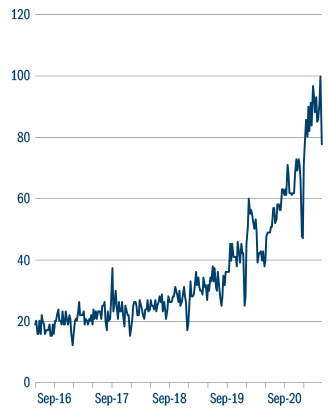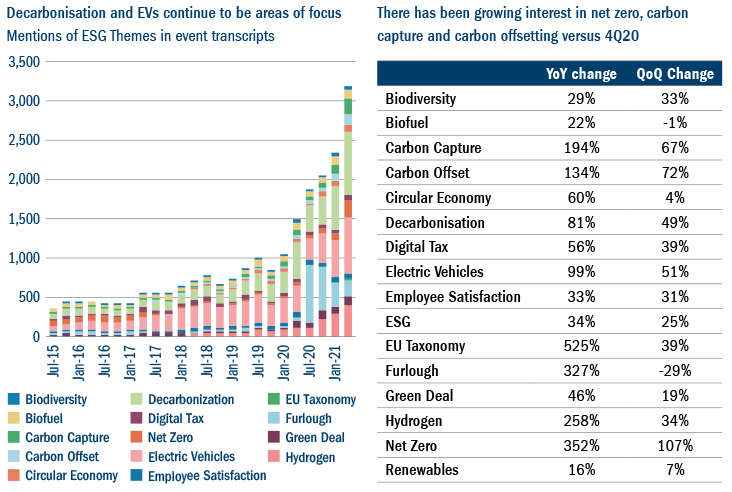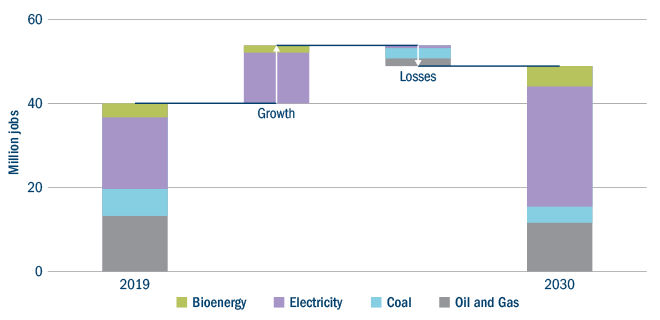Responsible Investment has witnessed
strong growth over the past five years.
However, the past six months have seen
it embark on a much steeper trajectory.
If we take a Google Analytics view
on worldwide searches for “ESG”
(environmental, social and governance)
phrases, it peaked in March 2021 (Figure 1).
This growth is also evident within corporate
transcripts with respect to the growing
usage of ESG themes (Figure 2).
Figure 1: Google Analytics returns for ESG phrases

Source: Google Analytics, May 2021. Numbers represent search
interest relative to the highest point on the chart for the given
region and time. A value of 100 is peak popularity. A value of
50 means the term is half as popular. A zero means there was
insufficient data for this item.
Figure 2: Key RI themes increasingly mentioned in company transcripts

Source: Alphasense (left) and Morgan Stanley (right), as at April 2021.
One of the enablers of this stellar growth has been strong policy support, particularly in Europe. The build out of
green infrastructure here is nothing if not ambitious. The European Union was among the first to commit to carbon neutrality – by 20501 – and has
gone furthest in publishing investment plans to enable a green transition. Some observers estimate that up to
€7 trillion in infrastructure spending will be required over the next 30 years to achieve
the EU’s stated goals, of which around €3 trillion will come from private sources.2
But while 2050 may seem a distant
prospect, the EU does not plan to start
its transformation slowly. The Green Deal,
which is the cornerstone of the continent’s
transition to a low-carbon future, aims
to deliver a reduction of 50%-55% in
carbon emissions by 2030 compared with
1990 levels.3 This will not be achieved
through new projects alone, developing
existing brownfield projects will be key
to supporting sustainable investment.
For investors, Europe’s gargantuan appetite
for green infrastructure investment will
inevitably lead to significant investment
opportunities. The Green Deal’s targets
imply an investment gap of around
€470 billion a year through to 2030.4
This will not be bridged without major
injections of private capital alongside state
spending and incentives, creating huge,
multi-year investment opportunities.
Aside from environmental benefits,
green infrastructure investment can also
accrue economic advantages through
the stimulation of economic activity –
a recent IMF5 paper concluded that every
dollar spent on carbon-neutral activities
generates more than a dollar of
economic activity, with this positive
multiplier effect persisting for at least
four years and the impact on economic
activity being two to seven times
larger than those associated with
environmentally detrimental measures.
Policies driving transformation
As Europe gears up to stimulate economic
recovery from Covid-19, so its plans
for green infrastructure investment
have increased. Joining forces with
the Green Deal, the EU Recovery Plan
gives climate transition a central role in
the continent’s blueprint for economic
recovery and growth, aiming to create
the jobs of the future as well as positive
climate and sustainability impacts,
including reduced emissions, greater
energy self-sufficiency and lower bills.
To support its Green Deal agenda, the
EU originally intended to mobilise at least
€1 trillion of public and private investment
by 2030, but the stimulus package drawn
up to address the economic impact
of Covid-19 has boosted this. The EU
Recovery Plan’s additional stimulus for
the period 2021-27 is expected to total
around €1.85 trillion, roughly a quarter
of which could be allocated to climate
transition-related investments.6 Additionally,
a €17.5 billion Just Transition Fund has
been agreed as part of the Green Deal to
mitigate the economic and employment
impacts of Europe’s climate transition.7
The EU’s Green Taxonomy will help
to drive private investment into green
infrastructure. This is an ambitious
attempt to classify economic activities
according to their sustainability, and is
intended to influence the way private
capital is allocated, alongside the less
prescriptive framework of the 17 UN
Sustainable Development Goals (SDGs).
Globally, the effort to achieve the SDGs
could create more than $12 trillion in
market opportunities8 across four key
areas – health and wellbeing, cities, energy
and materials and food and agriculture.
"For investors, Europe’s gargantuan appetite for green infrastructure investment will inevitably lead to significant investment opportunities"
1. Renewable energy
The plan calls for a doubling of electricity generation from renewable sources by 2030 to help meet its emissions reduction targets. This implies a major increase in European utility companies’ current rates of investment in renewable capacity and power grids. According to research carried out by the consultancy AT Kearney, annual renewables investment in Europe will rise from €60 billion in 2020 to €90 billion in 2022. By 2030, investment in European wind and solar capacity will total at least €650 billion and could reach €1 trillion.9 This is likely to boost utility valuations in Europe significantly, particularly given the big increase in demand that will result from the replacement of fossil fuels with electricity in transportation. It will also flow through to rising profits at equipment makers such as Danish turbine maker Vestas, which reported return on capital employed last year of around 20%.10
The plan calls for a doubling of electricity generation from renewable sources by 2030 to help meet its emissions reduction targets. This implies a major increase in European utility companies’ current rates of investment in renewable capacity and power grids. According to research carried out by the consultancy AT Kearney, annual renewables investment in Europe will rise from €60 billion in 2020 to €90 billion in 2022. By 2030, investment in European wind and solar capacity will total at least €650 billion and could reach €1 trillion.9 This is likely to boost utility valuations in Europe significantly, particularly given the big increase in demand that will result from the replacement of fossil fuels with electricity in transportation. It will also flow through to rising profits at equipment makers such as Danish turbine maker Vestas, which reported return on capital employed last year of around 20%.10
2. Green mobility
The transition to electric power for transport is a central element of the Green Deal, which stipulates that by 2030 at least 30 million zero-emission cars will be in use on Europe’s roads,11 high-speed rail travel will double across Europe and all scheduled mass transport for journeys of less than 500km should be carbon-neutral.12
The transition to electric power for transport is a central element of the Green Deal, which stipulates that by 2030 at least 30 million zero-emission cars will be in use on Europe’s roads,11 high-speed rail travel will double across Europe and all scheduled mass transport for journeys of less than 500km should be carbon-neutral.12
For some companies, these targets
present immediate opportunities to
generate attractive returns. Rail equipment
makers are well positioned to benefit from
the Green Deal, although an accelerated
transition to electric vehicles will pose
major challenges for automakers that
need to develop new vehicles and ensure
access to sufficient battery capacity.
3. Hydrogen as a future energy source
There is growing interest in hydrogen as a clean energy source, although it remains expensive relative to others. The cost of so-called “green hydrogen” – made using renewable electricity to power electrolysis of water – has fallen thanks to dramatically cheaper renewable energy, but remains seven times higher than fossil fuels. Hydrogen is also difficult to store and transport.13 However, it has major potential in areas where electrification is not feasible, such as heavy industry, trucks, shipping and seasonal energy storage, and the EU aims to grow the share of hydrogen in the bloc’s energy mix from less than 2% currently to 13%- 14% by 2050.14 To realise this potential, major policy support will be necessary to encourage investment. The European Commission estimates the carbon price under the EU’s Emissions Trading Scheme will need to rise from around €30 currently to €55-€90 a tonne.15 Examples of projects getting underway include Ørsted building a 1GW green hydrogen plant in the Dutch North Sea, which is slated for operations by 2030;16 and in the UK Cadent’s HyNet North West project, which has been awarded £72 million in funding, partly from the UK government, to finance a hydrogen carbon capture and storage (CCS) project. It is hoped the fresh capital will accelerate the project to a final investment decision by 2023 in order for the initial phase to become operational by 2025.17
There is growing interest in hydrogen as a clean energy source, although it remains expensive relative to others. The cost of so-called “green hydrogen” – made using renewable electricity to power electrolysis of water – has fallen thanks to dramatically cheaper renewable energy, but remains seven times higher than fossil fuels. Hydrogen is also difficult to store and transport.13 However, it has major potential in areas where electrification is not feasible, such as heavy industry, trucks, shipping and seasonal energy storage, and the EU aims to grow the share of hydrogen in the bloc’s energy mix from less than 2% currently to 13%- 14% by 2050.14 To realise this potential, major policy support will be necessary to encourage investment. The European Commission estimates the carbon price under the EU’s Emissions Trading Scheme will need to rise from around €30 currently to €55-€90 a tonne.15 Examples of projects getting underway include Ørsted building a 1GW green hydrogen plant in the Dutch North Sea, which is slated for operations by 2030;16 and in the UK Cadent’s HyNet North West project, which has been awarded £72 million in funding, partly from the UK government, to finance a hydrogen carbon capture and storage (CCS) project. It is hoped the fresh capital will accelerate the project to a final investment decision by 2023 in order for the initial phase to become operational by 2025.17
4. Building stock
Around three-quarters of the 220 million buildings in the EU are deemed energy inefficient.18 The EU’s Covid-19 recovery plan will channel major investment into upgrading them, given that buildings account for 36% of the EU’s greenhouse gas emissions and 40% of energy consumption. The plan’s key targets call for a 60% reduction in greenhouse gas emissions from buildings by 2030 and a cut in energy used for heating and cooling of 18%. To achieve this it aims to double the renovation rate of buildings to 2% over the next decade, which will require investment of €275 billion a year. Energy efficiency standards will also be tightened.19
Around three-quarters of the 220 million buildings in the EU are deemed energy inefficient.18 The EU’s Covid-19 recovery plan will channel major investment into upgrading them, given that buildings account for 36% of the EU’s greenhouse gas emissions and 40% of energy consumption. The plan’s key targets call for a 60% reduction in greenhouse gas emissions from buildings by 2030 and a cut in energy used for heating and cooling of 18%. To achieve this it aims to double the renovation rate of buildings to 2% over the next decade, which will require investment of €275 billion a year. Energy efficiency standards will also be tightened.19
These themes are consistent with
the opportunities we are seeing in
the infrastructure space, in particular
in the past 12 months those themes
linked to methods of decarbonisation
such as carbon capture, and solutions
around decarbonsiation (both
brownfield and greenfield), namely
hydrogen and carbon offsetting.
Thus, the supportive policy backdrop
is presenting sustainability-focused
openings within the small mid-cap nexus.
Don’t forget social!
This rapid move towards net zero
creates a risk that some people are
left behind – perhaps those without the
opportunity to reskill into low-carbon
industries or unable to access the
benefits of the new energy system.
The Just Transition acknowledges the
social implications of delivering net
zero, from jobs and training to working
with communities and ensuring no
one is left behind (Figure 3). Working
with our portfolio companies – and any
future ones – to ensure we create a
just transition for employees is of the
utmost importance, and strategies to
ensure positive social outcomes are
embedded in our business plans.
Figure 3: Global employment in energy supply in the net-zero pathway, 2019-2030

Source: International Energy Agency, 2019.
Looking forward, Europe’s drive to
green its economy will lead to a new
range of opportunities in infrastructure
investment. Indeed, Europe’s policymakers
are aware that they cannot achieve their
zero-carbon goals without attracting
private investment. Given the Green
Deal’s ambitious timeline over the
next 10 years, now is the time to be
exploring the major investment themes.





